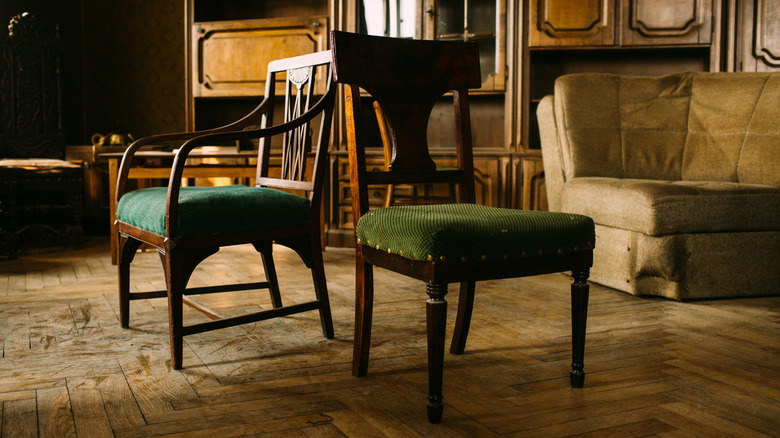How To Remove Bad Smells From Vintage Thrifted Furniture (Wood Or Upholstery)
We may receive a commission on purchases made from links.
While browsing at your local thrift store, you've unearthed the perfect end table or armchair, but as the dust settles around you, the joy of discovery is dampened by a distinct stench. Unlike furniture fresh from IKEA, second-hand pieces have been exposed to the lives — and smells — of other people, absorbing everything from cigarette smoke to perfume. This adds to their vintage charm in an abstract way, but in a more practical sense, you don't want to invite mid-century mustiness into your home.
Both wood and upholstered furniture can fall prey to funky smells, and while the solutions for freshening wood are more straightforward, upholstery can also be cleaned and deodorized. Though unpleasant smells are, well, unpleasant, don't let them stop you from grabbing that vintage ottoman, bookshelf, or other one-of-a-kind find. While you're there, make sure to pick up one item of vintage decor everyone's snatching up at thrift stores again.
Banish thrift-store stink from upholstery
You might have already cut your losses when it comes to getting that weird smell out of vintage upholstery, but don't give up hope. Lucky for you, the best way to clean anything second-hand is also the easiest — leave it out in the sun. Prolonged exposure to UV rays can work wonders when it comes to killing unseen mold and bacteria in soft fabrics. To get the most out of the sun, separate things like cushions and pillows from the main piece and lay them out, flipping them on occasion to make sure all the sides get toasted. The fresh outdoor air also helps to cycle out some smells.
Another low-effort cleaning agent is baking soda. After sprinkling a thick layer of baking soda over all the flat surfaces of your furniture, scrub it into all the corners and seams with a stiff-bristled brush and let it sit — preferably in the sun — for a full day. Once the baking soda has had time to settle in, vigorously vacuum the furniture and beat out any baking soda that remains.
If the more natural solutions fail you, you can turn to an upholstery cleaner and deodorizer like Woolite Carpet and Upholstery Cleaner. Once the furniture has been thoroughly cleaned, spray the upholstered portions with the cleaner and wipe down the surface with a wet rag, moving in the direction of the fabric weave. Vacuum one more time and let the item dry in the sun. Finally, if you don't mind investing some money into the cleaning process, try this upholstery cleaning hack.
Refreshing wood furniture without damage
The most effective way to freshen up any wood furniture is by sanding and refinishing it, but if you don't have the time, space, or resources for that, you have other options to get rid of lingering smells. Like with upholstery, you can separate the pieces of a wood furniture item and set them out in the sun, which will dry out any moisture stuck in the grain. If there's still a lingering smell, wipe down the piece with a one-to-one mixture of water and vinegar, being careful not to dampen the wood too much. To clear out smells in drawers and cabinets, you can leave cedar rings inside the closed spaces for a day or two.
Coating the piece with a scented furniture salve is a good idea even if the wood smells fine, since the salve will help hydrate the wood, leaving it shiny without refinishing. If the wood is cursed with a cigarette smell, products like the Zep Smoke Odor Eliminator can help clear that up, but be conservative when you spray, as any moisture could harm the wood, especially if its finish is damaged or missing in places. You can also reuse old tea bags to clean and polish old wood furniture.


